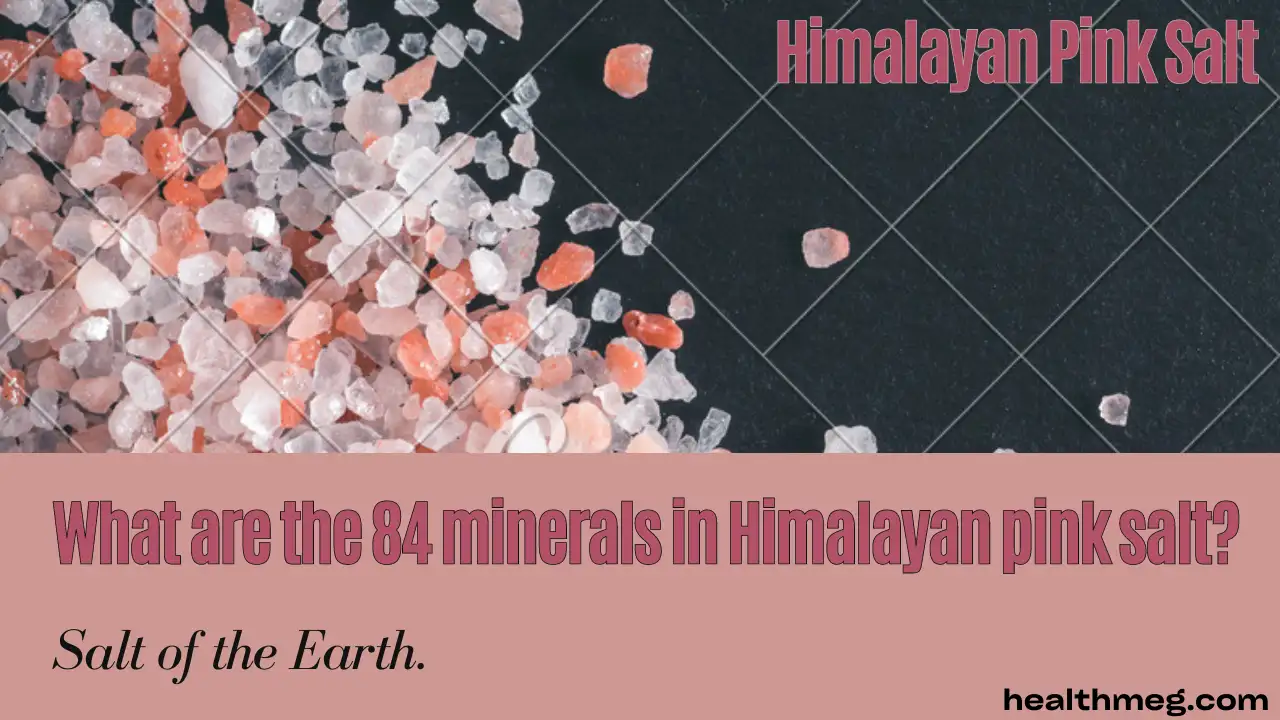Introduction
Himalayan pink salt has become extremely popular in recent years due to its rich pink colour and acclaimed health and culinary benefits. One of the key things that sets Himalayan salt apart is its high mineral content – with proponents claiming it contains 84 or even up to 94 trace minerals. But What are the 84 minerals in Himalayan pink salt?
In this article, we’ll provide a definitive list of the 84 specific trace minerals verified to be present in Himalayan pink salt through spectral analysis. We’ll also compare how Himalayan salt and table salt differ in mineral content and purity.
Do read the People Also Ask (FAQs) about this topic.
Key Takeaways
- Himalayan salt may contain 84 or more trace minerals that serve vital bodily roles like healthy enzyme function, muscular contraction, hydration and bone density.
- Independent lab reports are crucial for validating distributors’ assertions about mineral quantities in their salt products. Natural variability makes third-party verification important for consumer trust and safety.
- Natural mineral variability stemming from differing geographical salt origins can enrich nutritional intake when Himalayan salts from several sourcing locations are used.
- Credible guidance suggests moderate consumption of Himalayan pink salt combined with other unrefined salt varieties to ensure an ideal balance of essential trace minerals.
Sourcing the Purest Himalayan Pink Salt
While many brands claim their salt comes from the Himalayas in Pakistan, true, pure Himalayan salt should come from the Khewra Salt Mine – one of the oldest and purest salt mines in the world. The Khewra mine’s pink salt deposits formed over 250 million years ago from crystallized sea salt buried and compressed in the Himalayas over time.
Himalayan salt from other mines or regions cannot guarantee the same purity or mineral content. Buying pink salt labelled as sourced from the Khewra Salt Mine ensures you are getting the real thing.
Verifying the 84 Trace Mineral Claim
The 84 mineral claim for Himalayan salt seems to originate from a spectral analysis conducted by Dr. Barbara Hendel in 2003. Using high-tech laboratory methods, Dr. Hendel verified and listed the 84 specific ionic trace minerals she detected in samples of Himalayan pink salt from Pakistan. Every batch of salt, even from the same mine, can have slight variations in mineral content, however.
More recent spectral analyses, like this 2019 study published in the Salt Science Research journal, have detected up to 94 trace minerals in some tested samples of Himalayan pink salt from the Khewra Salt Mine. While the exact count may vary, it confirms the salt remains rich in a wide variety of essential trace minerals.
What are the 84 minerals in Himalayan pink salt?
Based on the most commonly referenced analysis, here are the 84 trace minerals that have been identified in Himalayan pink salt:
- Manganese
- Zinc
- Copper
- Iodine
- Phosphorus
- Sodium
- Chloride
- Potassium
- Calcium
- Magnesium
- Iron
- Silicon
- Vanadium
- Cobalt
- Nickel
- Sulfur
- Fluoride
- Boron
- Chromium
- Selenium
- Molybdenum
- Lithium
- Strontium
- Rubidium
- Thallium
- Bismuth
- Antimony
- Barium
- Titanium
- Aluminum
- Gallium
- Germanium
- Zirconium
- Niobium
- Cadmium
- Tungsten
- Lead
- Uranium
- Silver
- Gold
- Platinum
- Palladium
- Rhodium
- Ruthenium
- Indium
- Scandium
- Yttrium
- Lanthanum
- Cerium
- Uranium
- Neptunium
- Plutonium
- Americium
- Curium
- Berkelium
- Californium
- Praseodymium
- Neodymium
- Samarium
- Europium
- Gadolinium
- Terbium
- Dysprosium
- Holmium
- Erbium
- Thulium
- Ytterbium
- Lutetium
- Hafnium
- Tantalum
- Tungsten
- Rhenium
- Osmium
- Iridium
- Platinum
- Thallium
- Bismuth
- Polonium
- Astatine
- Francium
- Radium
- Actinium
- Thorium
- Protactinium
This covers macro minerals like calcium and magnesium we expect to see in salt as well as trace minerals that naturally occur from ancient rocks and minerals buried in the same region, many of which have perceived health benefits.
No other salt deposit on Earth has evidence supporting such a high and diverse mineral content as found in Himalayan pink salt.
Table Salt vs. Himalayan Pink Salt Minerals
In contrast to the rich mineral diversity in natural Himalayan pink salt, modern table salt is very heavily processed and stripped of minerals. Typical table salt consists almost entirely of just sodium chloride – 97.5% or higher.
All the naturally occurring trace minerals are removed from table salt during refining. Some brands then add back in small amounts of iodine and anti-caking agents, and that’s it.
Due to the intact mineral content and more natural sourcing, many health experts consider Himalayan pink salt a better choice over highly refined table salt. The dozens of trace minerals provide extra micronutrients missing from stripped, processed salts.
The Benefits of 84 Trace Minerals
While more research is still needed, early studies suggest the 84 trace minerals in Himalayan salt could have various health benefits:
- Supports electrolyte balance
- Contributes essential dietary minerals
- Provides key micronutrients missing from modern diets
- May support healthy blood pressure
- Could benefit respiratory health
- Helps regulate pH balance
- Potential anti-ageing antioxidant benefits
Again, more research is needed to confirm specific effects. But compared to table salt with just sodium and some added iodine, the extra minerals give Himalayan pink salt potential upsides.
The diversity and concentration of essential minerals give Himalayan pink salt standout qualities that make it unique among salts worldwide. Which is why it has earned such popularity.
Conclusion
Based on expert spectral analysis, Himalayan pink salt sourced from the ancient Khewra Salt Mine in Pakistan does indeed contain up to 84 or 94 trace minerals. The specific 84 minerals most commonly referenced include calcium, magnesium, iron, zinc, copper and 80 more ionic minerals our bodies rely on.
This unique mineral diversity, combined with more natural sourcing, makes Himalayan pink salt stand out from highly processed table salts. Early research suggests the full spectrum of minerals may also offer various synergistic health benefits.
So next time you use a rich pink salt labelled as sourced from the Khewra Salt Mine, you can trust that dozens of essential, hard-to-get trace minerals are coming along with the flavour.
People Also Ask (FAQs)
Q) Does Himalayan salt have 84 minerals?
A) Himalayan pink salt is often claimed to contain 84 or more trace minerals. Mineral content can vary slightly depending on the exact sourcing location. Third-party lab analysis through methods like spectroscopy should be examined to confirm the presence and levels of minerals claimed by any Himalayan salt brand.
Q) Which salt has 82 minerals?
A) No mainstream salt varieties have been reliably confirmed to contain exactly 82 minerals. This number appears to be a rounding of the 84 mineral claims made by some Himalayan pink salt brands. As noted, the exact mineral levels present can only be validated through spectral analysis by credentialed laboratories for each salt source and manufacturer.
Q) What is Himalayan salt rich in?
A) In spectral examinations, Himalayan pink salt has shown particular richness in trace minerals important for bone health like calcium, magnesium and phosphorus. It also frequently contains decent levels of electrolytes like sodium and potassium which help maintain healthy hydration and nerve function.
Q) Is selenium in pink Himalayan salt?
A) Yes, reputable lab analyses do detect notable levels of the essential trace mineral selenium in Himalayan pink salt. Selenium plays a vital role in thyroid hormone regulation, antioxidant protection and maintaining a robust immune system.
Q) 1 tsp Himalayan pink salt nutrition
A) A single teaspoon of Himalayan pink salt contains around 480 mg of sodium as table salt. The plethora of trace minerals it delivers is difficult to quantify per teaspoon but through regular moderate consumption, it can contribute to improved intake of minerals like iron, copper, calcium and zinc.
Q) Does Himalayan salt have magnesium?
A) Yes, most lab examinations of Himalayan pink salt have confirmed noteworthy concentrations of the macromineral magnesium critical for nerve and muscle function and cardiovascular health. This aligns with the abundance of magnesium tending to occur in ancient seabeds where Himalayan salt originated.
Q) How much Himalayan salt per day?
A) Credible health sources suggest limiting daily sodium intake to around 2,300 mg from all dietary sources. Overconsuming any salt variety can raise blood pressure issues. Consuming moderate amounts of high-mineral salts like 1-2 teaspoons of Himalayan pink salt daily as part of a balanced nutrition plan is considered safe and potentially beneficial by most medical experts.












